
Melaleuca amydra is a plant in the myrtle family, Myrtaceae and is endemic to the south-west of Western Australia. It is similar to Melaleuca ryeae with its small, compact form, oval leaves and "pom-pom" heads of pink to purple flower heads on the ends of the branches in spring.

Melaleuca barlowii is a plant in the myrtle family, Myrtaceae and is endemic to the south-west of Western Australia. It is similar to a number of other Western Australian melaleucas such as M. conothamnoides with its purple pom-pom flower heads but is a more erect shrub with different leaves and the fruiting clusters have a different shape.

Melaleuca beardii is a plant in the myrtle family, Myrtaceae and is endemic to the south-west of Western Australia. It is similar to a number of other Western Australian melaleucas such as M. trichophylla with its purple pom-pom flower heads but unlike others, the tips of its leaves are rounded rather than pointed.
Melaleuca boeophylla is a plant in the myrtle family, Myrtaceae and is endemic to the south-west of Western Australia. It is similar to a number of other Western Australian melaleucas such as M. filifolia with its purple pom-pom flower heads but its leaves are shorter and oval in cross-section.
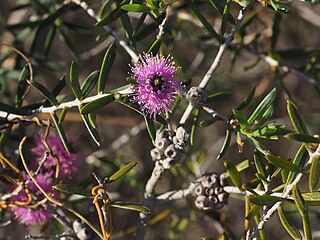
Melaleuca caeca is a plant in the myrtle family, Myrtaceae and is endemic to the south-west of Western Australia. It is similar to a number of other Western Australian melaleucas such as M. pentagona with its purple pom-pom flower heads but it is a smaller shrub with narrower leaves and smaller inflorescences.

Melaleuca campanae is a plant in the myrtle family, Myrtaceae and is endemic to the south-west of Western Australia. It is a small, woody shrub similar to Melaleuca eulobata, with a low, spreading habit and pinkish flower heads but it has longer, pointed leaves and lacks distinct sepals which instead form a ring of tissue around the edge of the flowers.
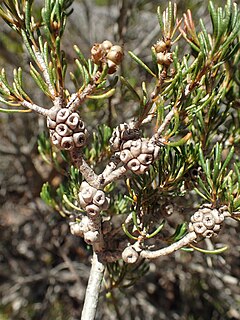
Melaleuca clavifolia is a plant in the myrtle family, Myrtaceae and is endemic to the south-west of Western Australia. It is a small shrub similar to Melaleuca tinkeri, with "pom-pom" heads of pinkish flowers and soft, silky hairs on the new growth but it has larger flower heads and its leaves are shorter, more club-shaped and have less distinct oil glands.
Melaleuca eximia is a plant in the myrtle family, Myrtaceae and is endemic to the south of Western Australia. It is distinguished by its leaf arrangement, its large, showy red inflorescences and the large, furry bracts under the flowers.
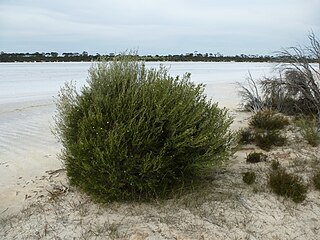
Melaleuca halophila is a plant in the myrtle family, Myrtaceae and is endemic to the south of Western Australia. It is a prickly shrub, similar to Melaleuca thapsina but its flowers are white and the leaves are shorter and hairier.

Melaleuca hnatiukii is a plant in the myrtle family, Myrtaceae and is endemic to the south of Western Australia. It is a medium to large shrub with arching branches, prickly tipped leaves and creamy-white heads of flowers in spring or early summer.

Melaleuca osullivanii is a plant in the myrtle family, Myrtaceae and is endemic to the south-west of Western Australia. It was first formally described in 2004 after a review of the broombush group, Melaleuca uncinata. It differs from others in the group by having leaves that are fine and circular in cross section. The closest other broombrush is Melaleuca hamata whose leaves are 0.8–1.6 mm (0.03–0.06 in) in diameter compared to 0.7–0.9 mm (0.03–0.04 in) for this species.

Melaleuca phoidophylla is a plant in the myrtle family, Myrtaceae and is endemic to the south-west of Western Australia. It is distinguished by its leaf arrangement, small raised blisters on the leaves and heads of white or cream flowers on the ends of the branches in spring.
Melaleuca procera is a plant in the myrtle family, Myrtaceae and is endemic to the south-west of Western Australia. It is an erect, spindly shrub with cylinder-shaped leaves and heads of pinkish flowers in later spring or early summer.

Melaleuca ryeae is a plant in the myrtle family, Myrtaceae and is endemic to the south west of Western Australia. It is a small shrub, closely resembling Melaleuca amydra with its small leaves and profuse heads of pink to purple flowers but M.amydra has narrower leaves and does not have spherical clusters of fruits.

Melaleuca sapientes is a plant in the myrtle family, Myrtaceae, endemic to the south-west of Western Australia. It is a small shrub with silky grey leaves and small heads of pinkish flowers in spring or early summer. The attractive, silvery foliage has made this melaleuca a popular garden plant under the incorrect name of Melaleuca holosericea, a similar but much rarer species.
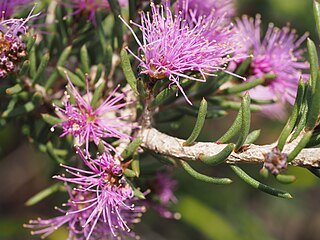
Melaleuca papillosa is a plant in the myrtle family, Myrtaceae and is endemic to the south-west of Western Australia. It is one of the smallest species of Melaleuca, distinguished by its narrow, usually hairy, pimply leaves, small heads of pink to purple flowers surrounded by silky hairs and scattered rather than clustered fruits.
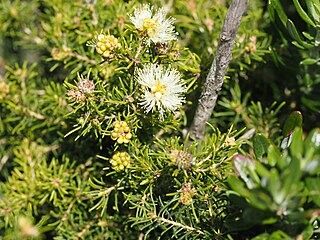
Melaleuca systena, commonly known as coastal honeymyrtle is a plant in the myrtle family, Myrtaceae and is endemic to the south-west of Western Australia. It was previously known as Melaleuca acerosa. It is a small shrub with crowded foliage and profuse heads of white to yellow flowers on the ends of its branches in spring.

Melaleuca wonganensis is an erect shrub in the myrtle family Myrtaceae and is endemic to the south-west of Western Australia. It is a shrub with narrow leaves and purple to deep mauve flowers and is restricted in its distribution to the Wongan Hills district.

Melaleuca coccinea, commonly known as the goldfields bottlebrush is a shrub in the myrtle family Myrtaceae and is endemic the south of Western Australia. It is distinguished by its unusual foliage and bottlebrush spikes of red flowers.

Melaleuca dichroma is a shrub in the myrtle family, Myrtaceae and is endemic to the south-west of Western Australia. It is unusual for its genus in that its flowers are yellow or creamy-white but age to a pinkish-red.

















